Table of Contents
To understand the chronological and logical order in which Powerbooks were released to the market and discontinued, please use the timeline map on the Powerbook 100 Series Wikipedia page.
Powerbook CPUs and Motherboards
| Model | Intro | CPU | Clock MHz | RAM MB On board | RAM MB Max | FPU | Motherboard | CPU Card |
|---|---|---|---|---|---|---|---|---|
| 100 | 1991 | 68000 | 16 | 2 | 8 | 1-640-290-12 | 1-640-491-12 | |
| 140 | 1991 | 68030 | 16 | 2 | 8 | 820-0409-08 | 820-0410-05 | |
| 170 | 1991 | 68030 | 25 | 2 | 8 | 68882 | 820-0409-08 | 820-0410-05 |
| 145 | 1992 | 68030 | 25 | 2 | 8 | 820-0409-A | 820-0410-A | |
| 160 | 1992 | 68030 | 25 | 4 | 14 | 820-0354-03 | 820-0356-01 | |
| 180 | 1992 | 68030 | 33 | 4 | 14 | 68882 | 820-0354-03 | 820-0356-8 |
| 165c | 1993 | 68030 | 33 | 4 | 14 | 68882 | 820-0354-03 | 820-0427-A |
| 145b | 1993 | 68030 | 25 | 4 | 8 | 820-0409-A | 820-0484-A | |
| 180c | 1993 | 68030 | 33 | 4 | 14 | 68882 | 820-0354-B | 820-0427-A |
| 165 | 1993 | 68030 | 33 | 4 | 14 | 820-0354-B | 820-0356-B | |
| 150 | 1994 | 68030 | 33 | 4 | 40 | 48.42801.002 | n/a | |
| 190 | 1995 | 68040 | 33 | 4/8 | 36/40 | 48.45701.001 | n/a | |
| 190cs | 1995 | 68040 | 33 | 8 | 40 | 48.45701.001 | n/a |
The Powerbook “generation” idea is not an official term. I use it to cluster together those Powerbooks, that existed simultaneously and addressed several different market ranges. In that way, models in a generation would get discontinued and replaced by the models of the succeeding generation.
First Generation of Powerbooks (1991-1992)
Powerbooks 100, 140 and 170 were introduced on 21st October 1991 and were targeting three segments that differed mainly by CPU, FPU and display capabilities.
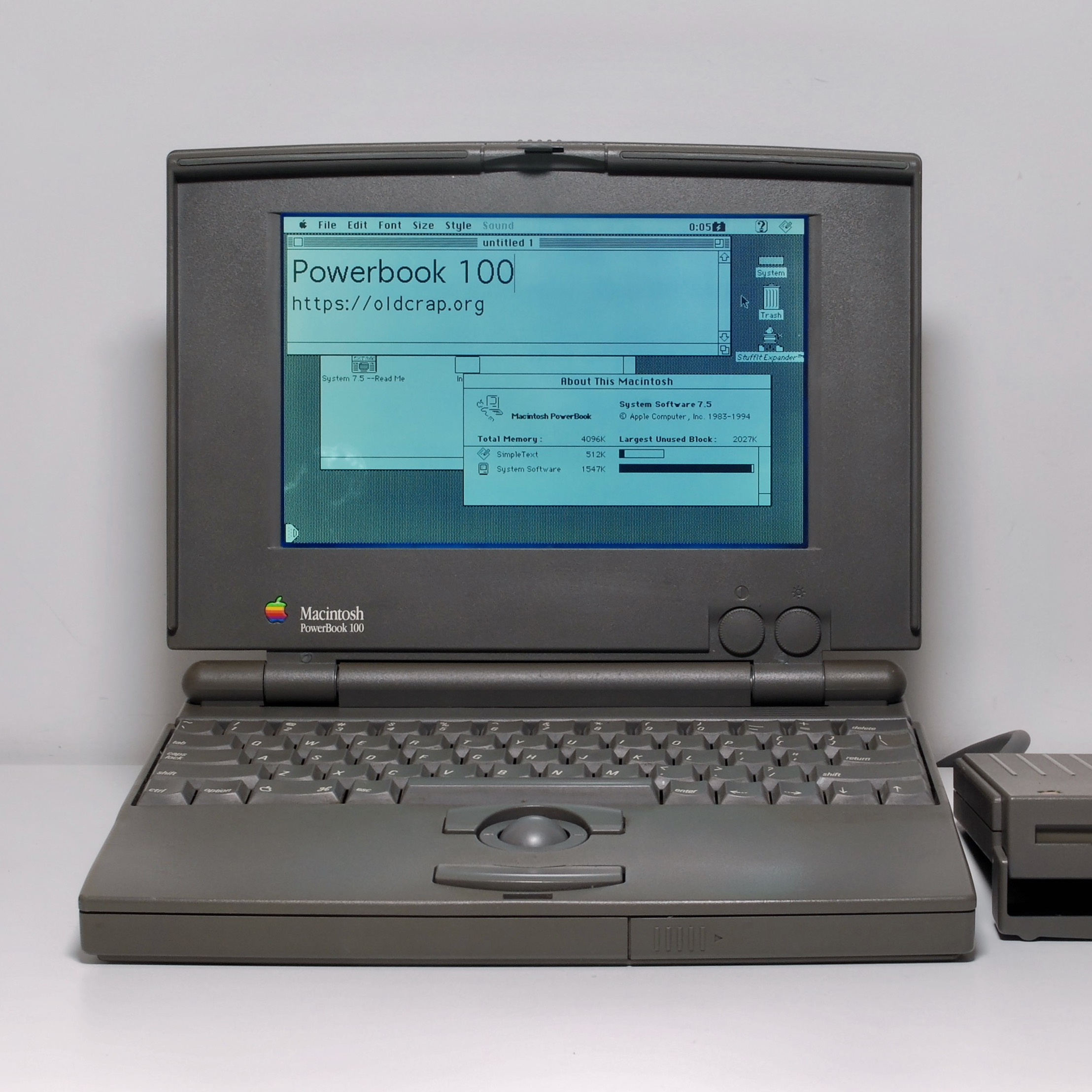
Powerbook 100
Low-range
16MHz 68000
2 or 4 MB RAM up to 8MB
9″ 640×400 mono
passive-matrix
20 or 40 MB SCSI HDD
$2500

Powerbook 140
Mid-range
16MHz 68030
2 or 4 MB RAM up to 8MB
9.8″ 640×400 mono
passive-matrix
20 or 40 MB SCSI HDD
$2900
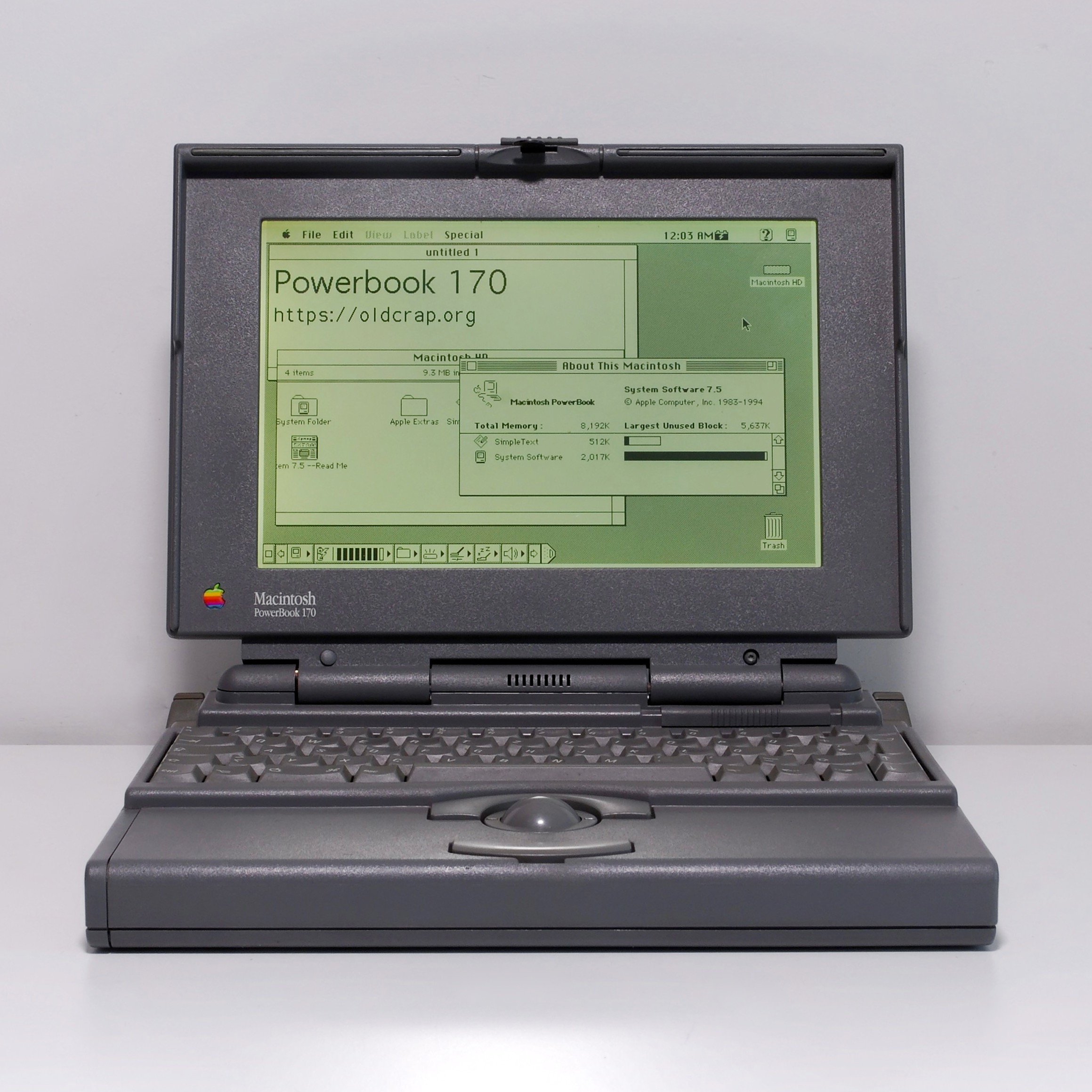
Powerbook 170
High-range
25MHz 68030 + 68882 FPU
4 MB RAM up to 8MB
9.8″ 640×400 mono
active-matrix
40 MB SCSI HDD
$4600
Powerbook 100
Powerbook 100‘s design was completely different to the rest of the line and it was based on Apple Portable computer. It is really hard to compare it to any other Powerbook.
Powerbooks 140 and 170
Powerbook 140 was the first to bring the specific form factor that would remain with Powerbooks up to 1995 and model 150. Models 140 (left) and 170 (right) shared the same motherboard design (820-0409-08).

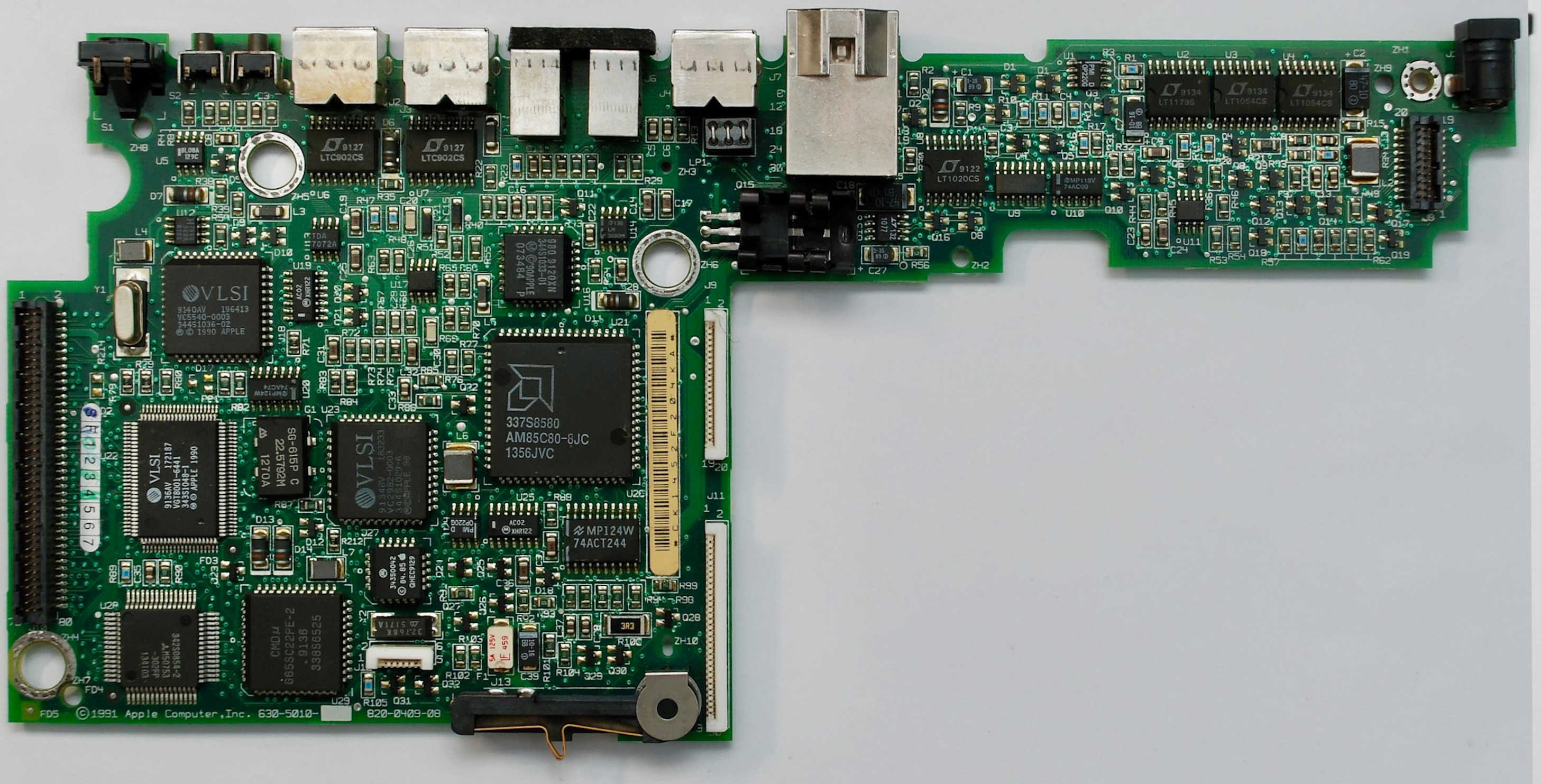
The CPU boards shared the same PCB (820-0410-05), but they had different clock oscillators and CPU clock rating (16 MHz in 140 and 25 MHz in 170).


Powerbook 170 had 68882 FPU soldered on the bottom side of the CPU board.


Second Generation of Powerbooks (1992-1994)
In 1992, a new generation of Powerbooks replaced models 100, 140 and 170. The weakest model 100‘s line was discontinued and its place in the low-range market took Powerbook 145. It replaced both models 100 and 140. In the high-range, model 170 was replaced by Powerbook 180. A new mid-range was created with Powerbook 160.
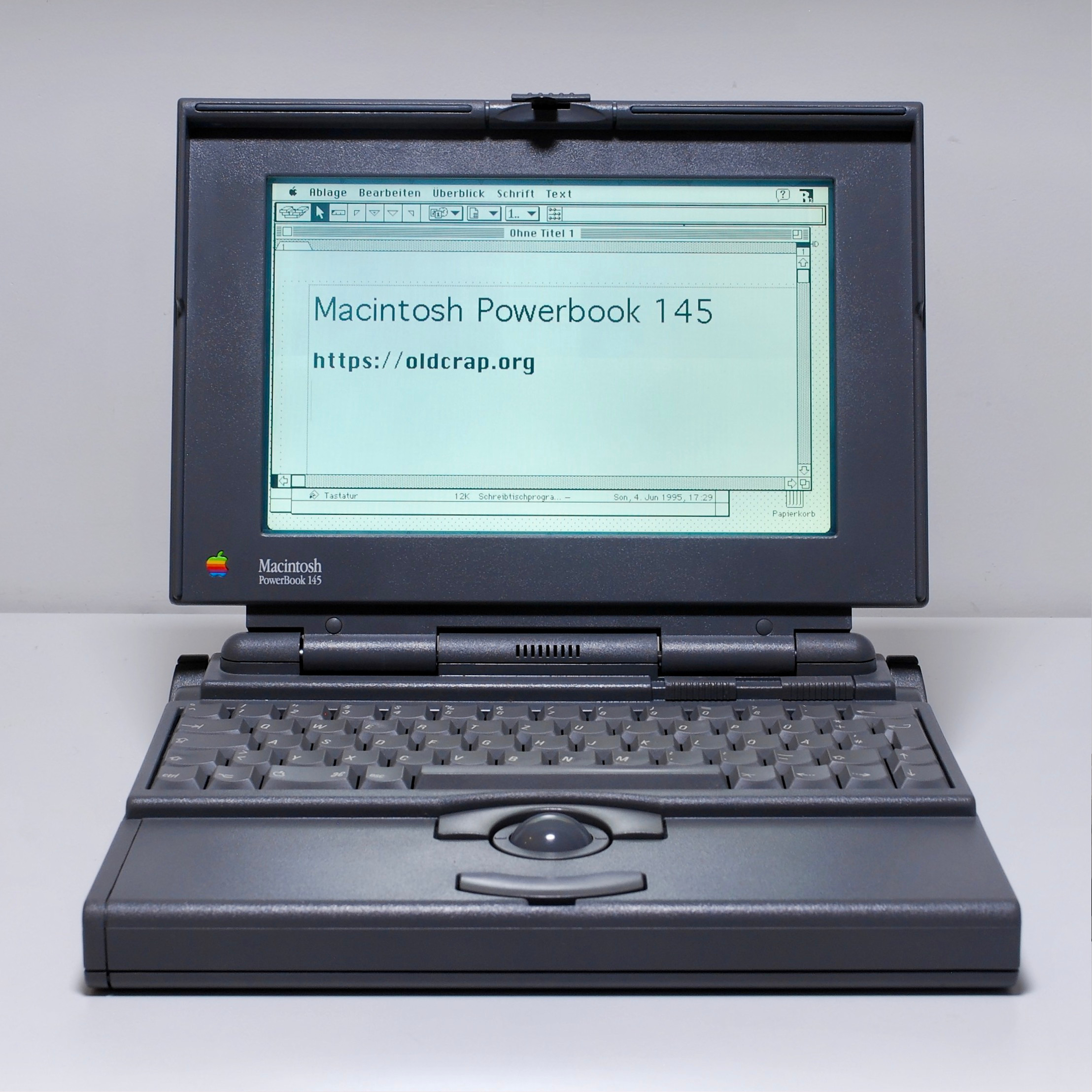
Powerbook 145
Low-range, replaced 140
25MHz 68030
4 MB RAM up to 8MB
9.8″ 640×400 mono
passive-matrix
40 or 80 MB SCSI
$2150

Powerbook 160
New mid-range
25MHz 68030
4 MB RAM up to 14MB
9.8″ 640×400 grayscale
passive-matrix, external video
40, 80 or 120 MB SCSI
$2430

Powerbook 180
High-range, replaced 170
33MHz 68030 + FPU
4 MB RAM up to 14MB
9.8″ 640×400 grayscale
active-matrix, external video
80 or 120 MB SCSI
$3870
Powerbook 145
Powerbook 145 received a very slightly updated motherboard (820-0409-A) comparing to 140 and 170 (820-0409-08). The top of the motherboards was visually identical, but the bottom side had small differences in some traces.


The CPU card of Powerbook 145 (820-0410-A) was something between CPU cards in models 140 and 170 (820-0410-05). It had the CPU upgraded to 33MHz clock, making the top part look exactly like in 170.


The bottom part of the CPU card in Powerbook 145 looked exactly like the one in model 140 – it was missing the FPU unit.


Powerbook 160
Powerbook 160 received a new upgraded DART motherboard (820-0354-03) with modified internal SCSI and CPU board connectors. The motherboard was substantially different to the design present in models 140, 170 (820-0410-05) and 145 (820-0410-A).


The CPU board (820-0356-01) of Powerbook 160 had a completely new design too with a larger footprint. An external video port and a larger internal display connector were added.


Powerbook 180
Powerbook 180 received the same motherboard as 160 (820-0354-03), upgraded from Powerbooks 140, 170 (820-0410-05) and 145 (820-0410-A).
The CPU card in 180 (820-0356-8) was upgraded comparing to 160 (820-0356-01) with a better clock. New clock components are likely hidden under the radiators, making the board visually identical to the one in 160.


The bottom part of the CPU card in 180 had FPU installed, comparing to the one in 160.


Upgrades to the Second Generation (1993-1994)
In 1993 Powerbook 145 was replaced with model 145b – 2MB of memory were moved from an external module to the CPU card to lower production costs.
Powerbook 160 offering was extended with a color screen model 165c, that also got a higher CPU clock and larger HDD sizes. 165c was sold for some time in parallel to the 160. In the fall of 1993, Powerbook 160 was finally replaced with Powerbook 165 – a degraded version of 165c, that received a grayscale screen and had the FPU removed.
In the high-range, Powerbook 180 continued until late 1994, but in 1993 it received a color alternative too – Powerbook 180c.

Powerbook 145b
Low-range, replaced 145
25MHz 68030
4 MB RAM up to 8MB
9.8″ 640×400 mono
passive-matrix
40 or 80 MB SCSI
$2150

Powerbook 165
Mid-range, replaced 160
33MHz 68030
4 MB RAM up to 14MB
9.8″ 640×400 grayscale
passive-matrix, external video
80 or 160 MB SCSI
$2430
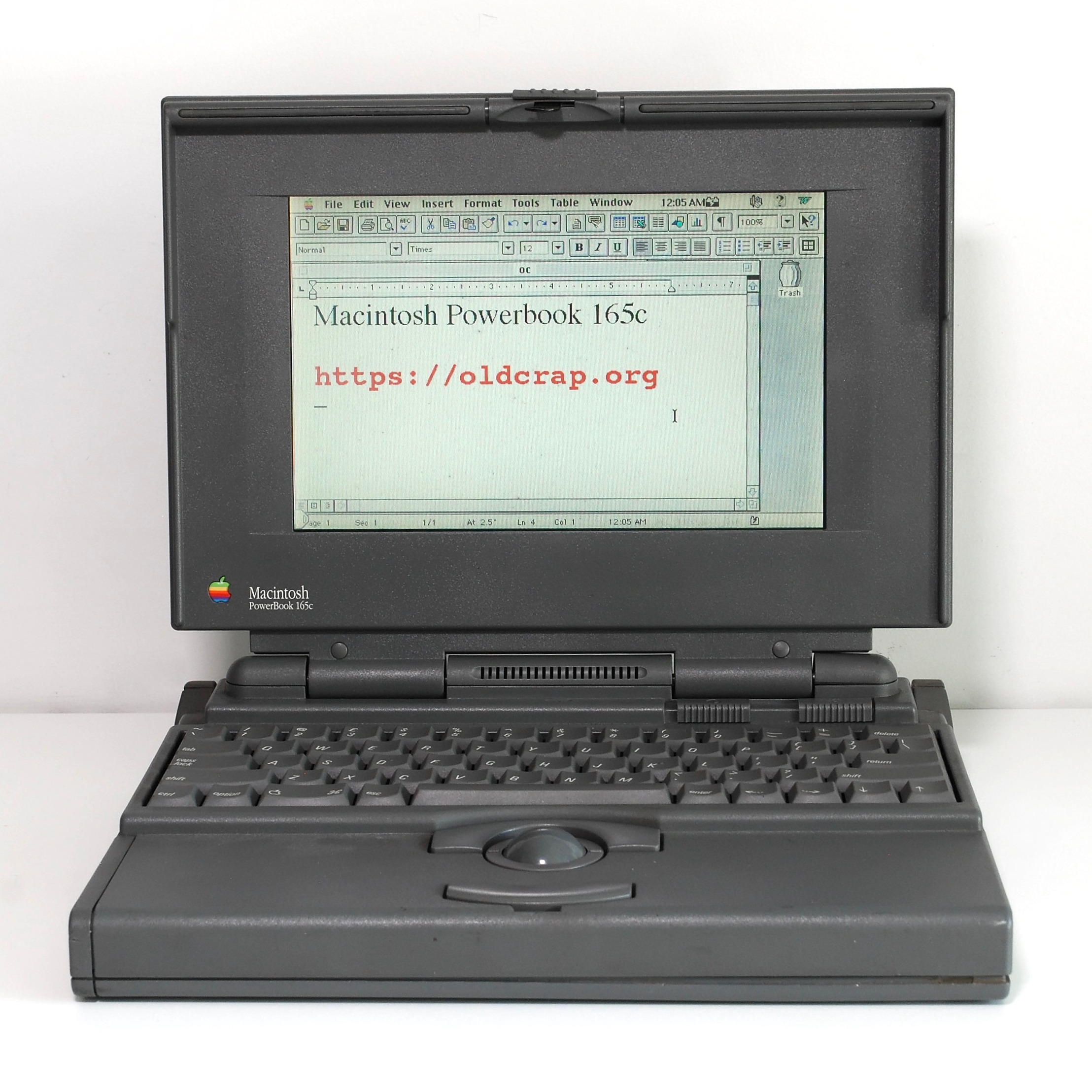
Powerbook 165c
Mid-range Color
33MHz 68030
4 MB RAM up to 14MB
8.9″ 640×400 color
passive-matrix, external video
80 or 160 MB SCSI
$3400

Powerbook 180c
High-range Color
33MHz 68030 + FPU
4 MB RAM up to 14MB
8.4″ 640×480 color
active-matrix, external video
80 or 160 MB SCSI
$4160
Powerbook 145b
Powerbook 145 had 2MB of memory soldered on the motherboard and extra 2MB coming in a form of an external memory module. Powerbook 145b moved the external 2MB of RAM to the CPU card (820-0484-A), near where the FPU resided on other models, limiting the production costs. The motherboard remained the same as in model 145 (820-0409-A). Unlike any other Powerbook before, it was also sold without the set of system installation disks, to further save the costs.
The top side of the CPU card looked almost the same, with some small changes visible.


The bottom part of the 145b CPU card (820-0484-A) was substantially different to the one in 145 (820-0410-A), accommodating four new memory chips.


Powerbook 165
Powerbook 165, comparing to model 160, offered an upgraded CPU clock from 25 to 33 MHz and larger HDD sizes. 165 motherboard (820-0354-B) showed no visible differences to the motherboard in 160 (820-0354-03) on both sides of the PCB. CPU card in Powerbook 165 (820-0356-B), comparing to the CPU card in 160 (820-0356-01) had upgraded CPU clock oscillators. They were covered by the rubber radiators and the difference was not visually noticable.


Powerbook 165c
The main advantage of Powerbook 165c over Powerbook 160, and later 165, was a color display and FPU. When it was released, it also offered a higher 33 MHz CPU clock than 25 MHz in 160.
165c had the same motherboard as 160 and 180 (820-0354-03). The CPU card (820-0427-A) was substantially different to the one in models 160 (820-0356-01) and 165 (820-0356-B). A second memory slot was added to the CPU card, possibly offloading the chips present on the card before.


Powerbook 180c
The main advantage of Powerbook 180c in the high range market, comparing to model 180, was an active-matrix color display with higher resolution of 640×480. 180c shared the same motherboard with 160, 165, 165c and 180 (I noticed two variants of that motherboard: 820-0354-B and 820-0354-03). It also had the same CPU board as Powerbook 165c. Basically, 180c differed to 165c by a better display and larger HDD sizes available.
Third Generation of Powerbooks and the end of 100 series (1994-1995)
In 1994 the low, middle and high range models of Powerbooks were all replaced by new models. Powerbook 145b in the low range was replaced by Powerbook 150. Instead of 165/165c middle range models, a new design of Powerbooks 520 and 520c was introduced (outside of scope of this post). The high-end range Powerbooks 180 and 180c were superseded by models 540, 540c and 550c (also outside of scope of this post). In the fall of 1995 two new Powerbooks 190 and 190cs were introduced as an actual replacement for the 500 series. They followed the 5300 series form factor, could have been upgraded to PowerPC CPU and were the last Powerbooks to use Motorola 68k processors.
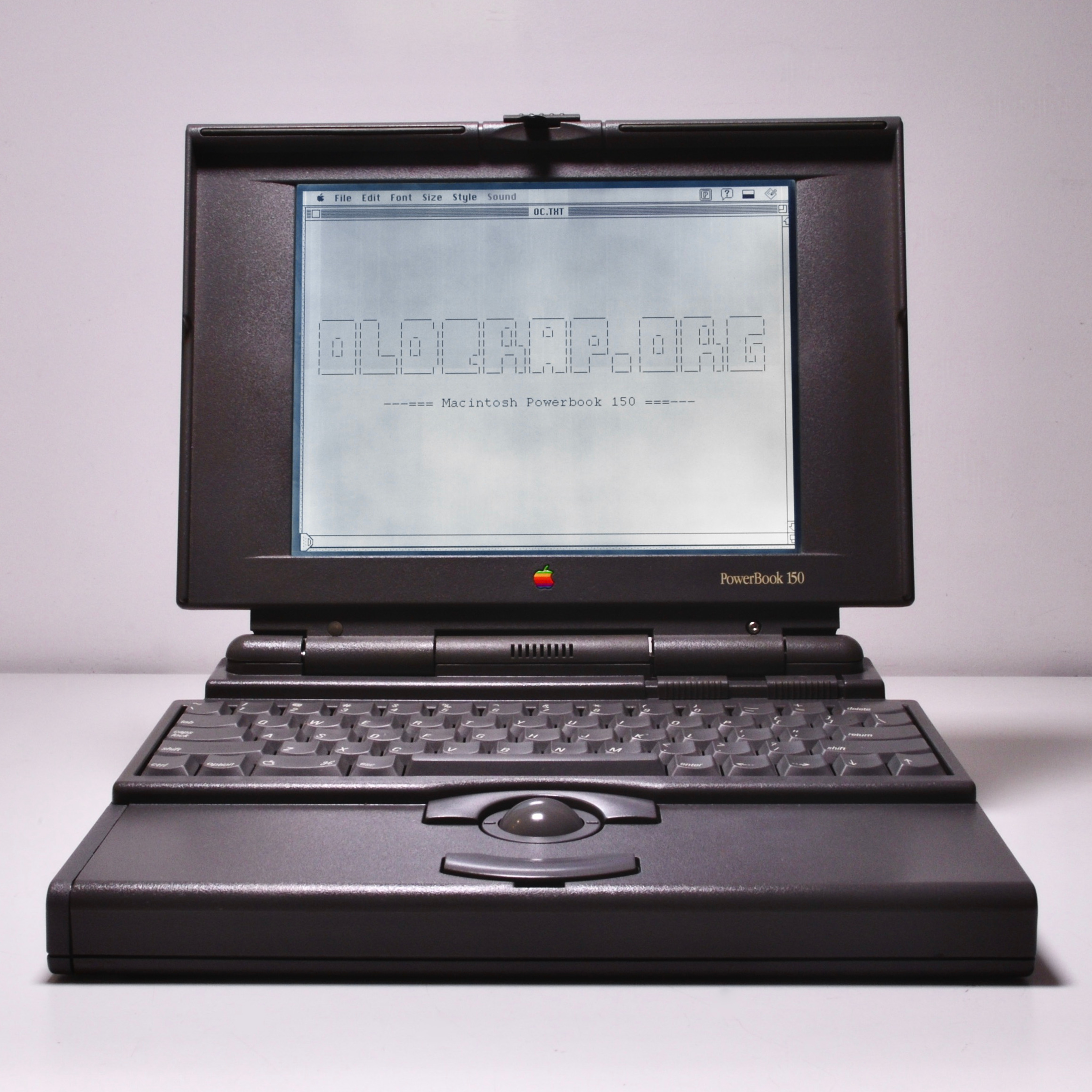
Powerbook 150
Low-range, replaced 145b
33MHz 68030
4 or 8MB RAM up to 40MB
9.5″ 640×480 grayscale
passive-matrix
150 or 250 MB IDE
$1450
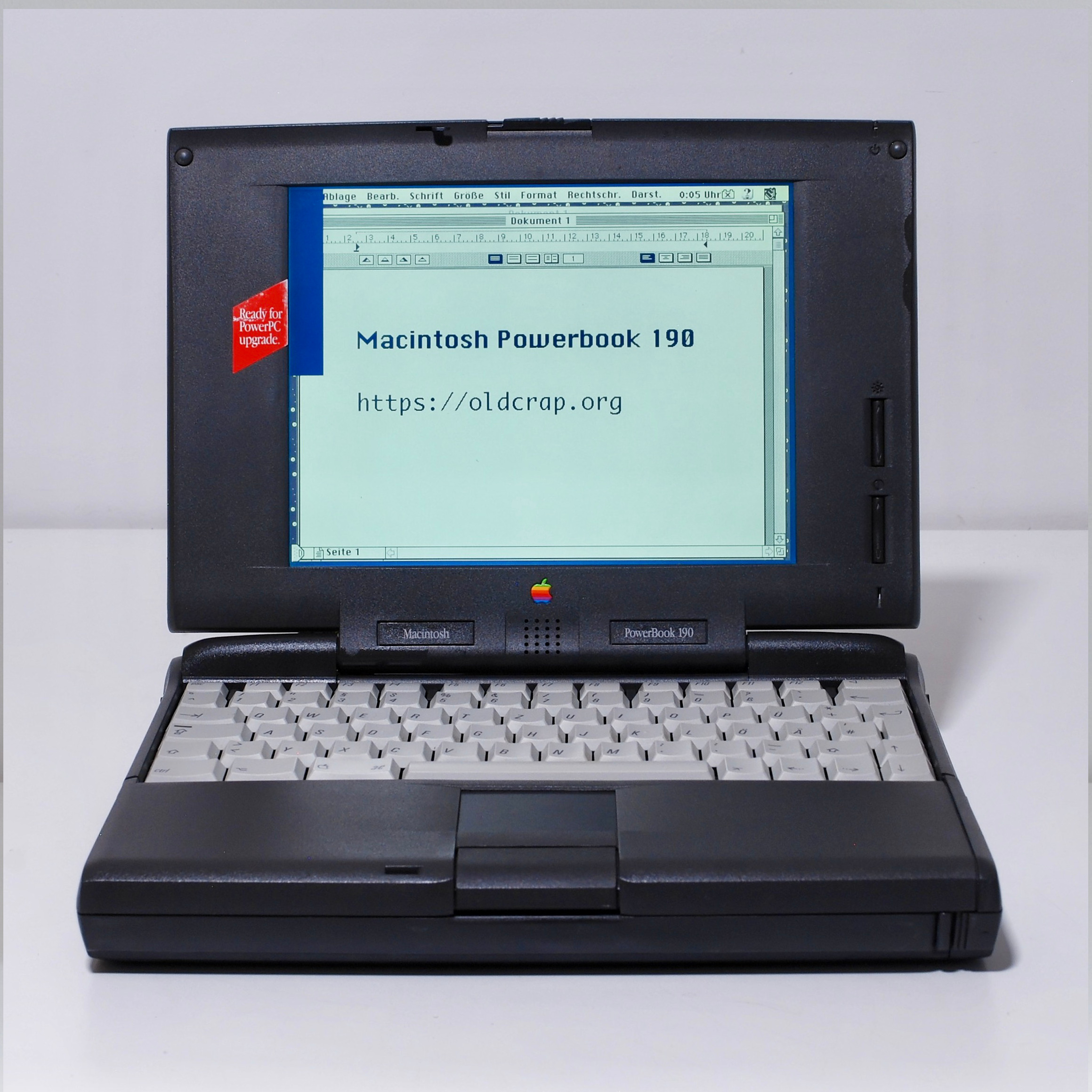
Powerbook 190
End of 100s, replaced 500s
33MHz 68040
4 or 8MB RAM up to 40MB
9.5″ 640×480 grayscale
passive-matrix
500 MB IDE
$1650

Powerbook 190cs
End of 100s, replaced 500s
33MHz 68040
8MB RAM up to 40MB
10.4″ 640×480 color
passive-matrix
500 MB IDE
$2200
Powerbook 150
Powerbook 150 introduced a new internal design that was based on Powerbook Duo 230, which allowed to utilise more than 14MB of memory. It was also the last one to use the original case design and a trackball. CPU was integrated with the motherboard, ADB port and dual display support were removed. This was also the first Powerbook to use IDE hard drive interface.


Powerbooks 190 and 190cs
Powerbooks 190 and 190cs were really a continuation of Powerbook 500 line and were the last Powerbooks to use Motorola CPUs. They had a completely different design to other 100 series Powerbooks and should be compared against Powerbook 5300 which design it shared. Both 190 and 190cs machines used the same motherboard with integrated CPU and only had different displays.


Powerbook Displays
The configurations of displays, backlight inverters and interconnecting boards are described here based on the real machines that are in my collection. It is possible, that other combinations existed on the market or different components were used for some of the Powerbooks. Please use the data with caution.
M – monochrome display
G – grayscale display
C – color display
A – active matrix display
D – dual display (external video connector)
B – microphone built in laptop’s base
S – microphone built in laptop’s screen
| Model | Intro | Display | Inverter | Interface | Video | Matrix | Dual | Mic | ||
|---|---|---|---|---|---|---|---|---|---|---|
| 100 | 1991 | Sharp | LM64P791 | TDK | KU-02194V-0N PCU-659B | 1-640-493-12 | M | |||
| 140 | 1991 | Sharp | LM64P51 | TDK | CXA-0112 PCU-662A | 820-0411-02 | M | |||
| 170 | 1991 | Hosiden | HLR1014-101125 | Hosiden | MEC-37AV-0 HLR1014-103802 | 820-0411-02 | M | A | ||
| 145 | 1992 | Sharp | LM64P58 | TDK | CXA-2010 PCU-773 | 820-0411-02 | M | |||
| 160 | 1992 | Sharp | LM64P58 | TDK | CXA-0112 PCU-662A | 820-363-01 | G | D | B | |
| 180 | 1992 | Hosiden | HLR1021-101182 | TDK | CXA-2011 PCU-734 | 820-363-01 | G | A | D | B |
| 165c | 1993 | Sharp | LM64C06P | TDK | TDK CE-2112 PCU-721B | 820-0419-A | C | D | B | |
| 145b | 1993 | Sharp | LM64P58 | TDK | CXA-2010 PCU-773 | 820-0411-02 | M | |||
| 180c | 1993 | Sharp | LQ9D01A | Unknown | DC-290 | 820-0438-A | C | A | D | B |
| 165 | 1993 | Sharp | LM64P582 | TDK | CXA-2010 PCU-773 | 820-363-01 | G | D | B | |
| 150 | 1994 | Sharp | LM64183P | TDK | DAC-0510JP | 48.42903.00 | G | |||
| 190 | 1995 | Casio | MD805TT00-C1 | Apple | 820-0569-A | n/a | G | S | ||
| 190cs | 1995 | Torisan | LM-CJ53-22NAK | Apple | 820-0569-A | n/a | C | S |
LCD Screens
Most of the Powerbook screens were manufactured by Sharp and a few by Torisan, Casio and Hosiden.













Backlight Inverters
Majority of inverters used to power CCFL display backlights were manufactured by TDK. Inverter boards (except for Powerbook 100, which had a separate board) had also brightness and contrast control potentiometers or buttons installed. Majority of Powerbooks had both controls. Inverters in models 170 and 180c had only one control for brightness. Models 165c and 180c had also a second inverter board installed in the screen lid.









Interconnect Boards
Interconnect boards linked the motherboard to the backlight inverter, screen, keyboard and trackball. It also contained a speaker, a microphone (for models which included the built-in mic) and a backup battery. In most cases the interface was a simple interconnect board without any logic. Only for model with microphones, there was a small circuit soldered.
Please note on the picture that interconnect board from Powerbook 150 has bodge wires installed to fix broken traces and board from Powerbook 180c has a motherboard tape cable replaced from ASUS PC motherboard.






Display Covers
There were four types of display cover in Powerbook 100 series. Powerbook 100, having a completely different design and case had the first type, with Apple logo in the corner.
The most popular cover was in Powerbooks 140, 145, 145b, 160, 165, 170 and 180. Like in Powerbook 100, it had the logo in the corner.
Color versions of Powerbooks: 165c and 180c had a thicker screen and had to implement a different cover. This time, the logo was placed in the center.
Finally, Powerbooks 190 and 190cs had a completely new case design that was shared with Powerbook 5300 and so they got new display cover design too.




Models, which have no built-in microphone (140, 145, 145b, 150, 160, 170) had a speaker grille with 9 holes.
Models with a built-in microphone (160, 165, 165c, 180, 180c) had a wider speaker grille with 21 holes and three holes for the microphone in the base.

Powerbook Floppy Disk Drives
Powerbook 100 was missing an internal FDD. All the other Powerbooks until 1994 (140, 145, 145b, 160, 165, 165c, 170, 180, 180c) used Sony MPF22A-01.


1994 and 1995 models: 150, 190 and 190cs used Mitsubishi Electric MF355H-498MA.


Powerbook Hard Drives
Majority of Powerbook 100 series hard drives were SCSI. Only the latest Powerbooks 150, 190 and 190cs supported IDE drives. The following sections show examples of the original drives that were mounted in my machines.
Conner Drive
40MB SCSI Conner CP2045 was found in the earliest Powerbooks 100 and 140.










Quantum GoDrive
40MB SCSI Quantum GoDrive was mounted in models 145, 145b and 170.






80MB version of the GoDrive from Powerbook 165.


IBM Drive
80MB IBM WDS-280 found in Powerbook 160.



120MB IBM WDS-2120 found in Powerbooks 165c and 180.



More modern 500MB IDE drive IBM DB0A-2540 from Powerbooks 190 and 190cs.



Powerbook Keyboards
All Powerbook 100 series except for models 100, 190 and 190cs used the same keyboard design that should be interchangeable between models.


These keyboards came in two colors: light and dark grey.


Powerbook 100 keyboard was different and specific to that model only. Powerbook 190 and 190cs keyboards were probably compatible with the machines sharing the same case design (Powerbook 5300).
Powerbook Trackballs
All 100 series Powerbooks, except for model 100 (which has a dedicated trackball) and 190/190cs (which have trackpads) used the same Logitech trackball marked as Bullseye 220247. The two revisions of the trackball PCB: A and B differed by the type of components used on the board. Revision B was present in Powerbook 150 and revision A in all others.


Powerbook I/O Interfaces
FDD – HDI-20 floppy disk drive connector
HDD – HDI-30 hard disk drive connector
ADB – ADB port for external mouse/keyboard
SER – serial port
SND OUT – audio out port (mini jack)
SND IN – sound in or microphone port (mini jack)
VID OUT – external monitor port
PWR SW – power on/off switch
RES – reset button
INT – interrupt button
Y – supported
O – optional
| Models | FDD | HDD | ADB | SER | SND OUT | SND IN | VID OUT | PWR SW | RES | INT | Comments |
|---|---|---|---|---|---|---|---|---|---|---|---|
| 100 | Y | Y | Y | 1 | Y | Y | Y | Power on with space Battery cut-off switch Reset/Int on the side | |||
| 140 145 145b 170 | Y | Y | 2 | Y | Y | Y | Y | Y | |||
| 160 165 165c 180 180c | Y | Y | 2 | Y | Y | Y | Y | Y | Y | ||
| 150 | Y | 1 | Y | Y | |||||||
| 190 190cs | Y | Y | 1 | Y | O | O | Y | Power on keyboard Optional infrared port |
Powerbook Power Supply Units
| Model | Voltage | Max Current |
|---|---|---|
| 100, 140, 145, 145b, 150, 160, 165, 170, 180 | 7.5V DC | 2A |
| 165c, 180c | 7.5V DC | 3A |
| 190, 190cs | 24V DC | 1.9A |












The three plug standards on Powerbook PSUs:

















